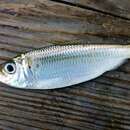en
names in breadcrumbs


Harengula jaguana és una espècie de peix pertanyent a la família dels clupèids.[5]
A Mèxic és depredat per Arius felis i Arius melanopus, i als Estats Units pel nodi comú (Anous stolidus) i el xatrac fosc (Sterna fuscata).[9][10]
És un peix marí i d'aigua salabrosa, associat als esculls[11] i de clima tropical (43°N-37°S, 99°W-33°W) que viu fins als 22 m de fondària (normalment, entre 1 i 5).[6][12][13][14]
Es troba a l'Atlàntic occidental: des de Nova Jersey (els Estats Units) i Bermuda fins a Florida, el golf de Mèxic,[15][16][17] el mar Carib i el sud del Brasil.[18][19][6][20][21][22][23][24][25][26][27][28][29][30][31][32][33][34][35][36][37][38][39][40][41][42][43][44][45][46][47]
Pot assolir els 3 anys d'edat.[48]
Es comercialitza fresc o en conserva.[6]
És inofensiu per als humans.[6]
The scaled sardine, Harengula jaguana, is a herring-like fish in the family Clupeidae. It is native to coastal waters of the western Atlantic Ocean, from the Gulf of Mexico (where it is known as the pilchard or whitebait) down to Brazil where it is called mata.
It has a solid back with dark streaks and usually a small dark spot at the upper edge of the operculum and sometimes one located at the shoulder. It grows up to 9 inches (23 cm) in length but typically is little more than half that size.
It is a fast-growing species, living only 12 to 18 months.
Scaled sardines are often referred to by anglers as greenbacks, though that name belongs to the Atlantic Threafin herring. They can usually be caught with strings of wire loops known as minnow rings, sabiki rigs or by cast netting.
They are taken by anglers for use as bait or for personal consumption.[2]
Also known as pilchard and greenback.
The scaled sardine, Harengula jaguana, is a herring-like fish in the family Clupeidae. It is native to coastal waters of the western Atlantic Ocean, from the Gulf of Mexico (where it is known as the pilchard or whitebait) down to Brazil where it is called mata.
It has a solid back with dark streaks and usually a small dark spot at the upper edge of the operculum and sometimes one located at the shoulder. It grows up to 9 inches (23 cm) in length but typically is little more than half that size.
It is a fast-growing species, living only 12 to 18 months.
Scaled sardines are often referred to by anglers as greenbacks, though that name belongs to the Atlantic Threafin herring. They can usually be caught with strings of wire loops known as minnow rings, sabiki rigs or by cast netting.
They are taken by anglers for use as bait or for personal consumption.
Harengula jaguana Harengula generoko animalia da. Arrainen barruko Clupeidae familian sailkatzen da.
Harengula jaguana is een straalvinnige vissensoort uit de familie van haringen (Clupeidae).[1] De wetenschappelijke naam van de soort is voor het eerst geldig gepubliceerd in 1865 door Poey.
Bronnen, noten en/of referenties